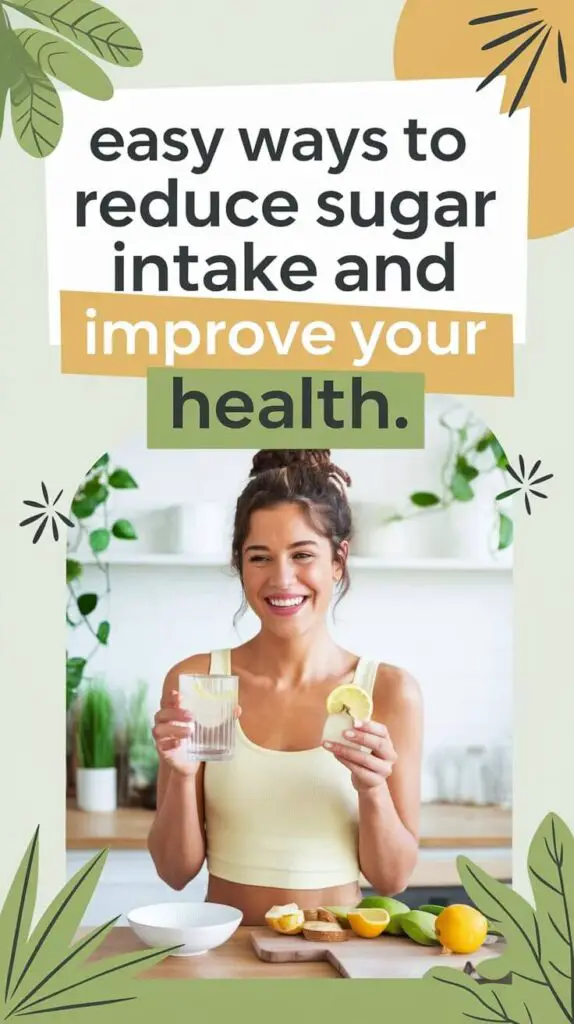Sugar is everywhere. From your morning coffee to the sauces in your favorite meals, it sneaks into places you might not expect. I used to think my sugar intake wasn’t a problem until I realized how much it affected my energy levels, focus, and even my sleep. Making the decision to reduce sugar was one of the best choices I’ve made for my health. In this article, I’ll share easy ways to cut back on sugar, why it matters, and some tips I’ve learned from personal experience.

Why Reducing Sugar is Important
Too much sugar can lead to various health issues, such as weight gain, diabetes, heart problems, and even mood swings. When I first started noticing frequent energy crashes in the afternoon, I didn’t connect it to the sugary snacks I was having. It wasn’t until I started tracking what I ate that I saw how much sugar was a regular part of my diet. Cutting back made a big difference.
Reducing sugar intake not only helps maintain a healthy weight but also improves your overall well-being. You feel more energetic, sleep better, and even notice clearer skin over time.
Start by Understanding Where Sugar Hides
The first step to reducing sugar is knowing where it’s hiding. It’s not just in desserts and candies. Many processed foods, like bread, salad dressings, ketchup, and even yogurt, contain added sugars.
I remember being surprised when I checked the label on my favorite granola bar—it had more sugar than a candy bar. Reading food labels became a habit for me. Look for words like “high fructose corn syrup,” “sucrose,” or anything ending in “-ose.” These are all forms of sugar.
Swap Sugary Drinks for Healthier Options
One of the easiest ways to cut back on sugar is by focusing on what you drink. Sodas, flavored coffees, and even fruit juices can be loaded with sugar.
I used to grab a flavored latte every morning, thinking it was just coffee. After switching to plain coffee or tea with a splash of milk, I noticed my energy levels felt more stable. For something refreshing, I started infusing water with slices of lemon, cucumber, or berries.
Choose Whole Foods Over Processed Foods
Processed foods are a major source of hidden sugars. Sticking to whole foods—like fruits, vegetables, whole grains, and proteins—makes it easier to avoid added sugars.
When I started meal prepping at home, I could control exactly what went into my meals. For example, I now make my own tomato sauce instead of buying the jarred version, which often contains added sugar.
Satisfy Sweet Cravings Naturally
Cutting out sugar doesn’t mean you can’t enjoy something sweet. I’ve learned to satisfy my cravings with naturally sweet foods like fruits. A bowl of berries with a sprinkle of cinnamon or a frozen banana blended into a smoothie can feel just as indulgent as dessert.
Another tip is to pair your fruit with protein or healthy fat, like apple slices with peanut butter. This not only satisfies your sweet tooth but also keeps you full for longer.
Learn to Cook at Home
Cooking at home is a game changer. It’s one of the best ways to control your sugar intake. When you cook your meals, you know exactly what’s going into them.
I started experimenting with simple recipes for snacks and meals. Instead of buying store-bought muffins, I bake my own using less sugar and healthier ingredients like whole wheat flour and applesauce.
Read Food Labels Carefully
Learning to read food labels is an essential skill. Many products labeled as “low fat” or “healthy” compensate for the lack of fat by adding more sugar.
A personal trick I’ve adopted is sticking to products with no more than 5 grams of sugar per serving. This simple habit helps me make better choices without feeling overwhelmed.
Be Mindful When Eating Out
Restaurant meals often contain hidden sugars in dressings, sauces, and marinades. When dining out, I started asking for dressings on the side or opting for simpler dishes with fewer sauces.
I’ve also learned that skipping dessert doesn’t mean missing out. Sometimes, I order a fresh fruit platter or a simple espresso instead.
Limit Sugary Snacks at Home
One of the easiest ways to avoid sugar is to keep tempting snacks out of the house. If it’s not there, you’re less likely to eat it.
I’ve swapped out sugary treats for healthier options like nuts, seeds, or plain popcorn. Having these on hand helps me stay on track.
Give Yourself Time to Adjust
Cutting back on sugar doesn’t have to happen overnight. It’s a process, and your taste buds will adjust over time. When I first reduced sugar, I missed the sweetness in my coffee or cereal. But within a few weeks, I found that I actually enjoyed the natural flavors more.
The Benefits I’ve Noticed
Since reducing sugar, I feel more energetic throughout the day. My focus has improved, and I no longer experience those afternoon slumps. I’ve also noticed that I sleep better and feel less bloated.
Small changes, like swapping sugary drinks for water or choosing fresh fruit over packaged snacks, can make a big difference.
Conclusion
Reducing sugar intake doesn’t mean giving up on flavor or enjoyment. It’s about making small, manageable changes that add up over time. Whether it’s reading food labels, cooking at home, or choosing natural sweetness, these steps can improve your health and well-being.
The key is to start small and be consistent. Over time, you’ll notice the benefits—not just in how you feel but in your overall health too.
